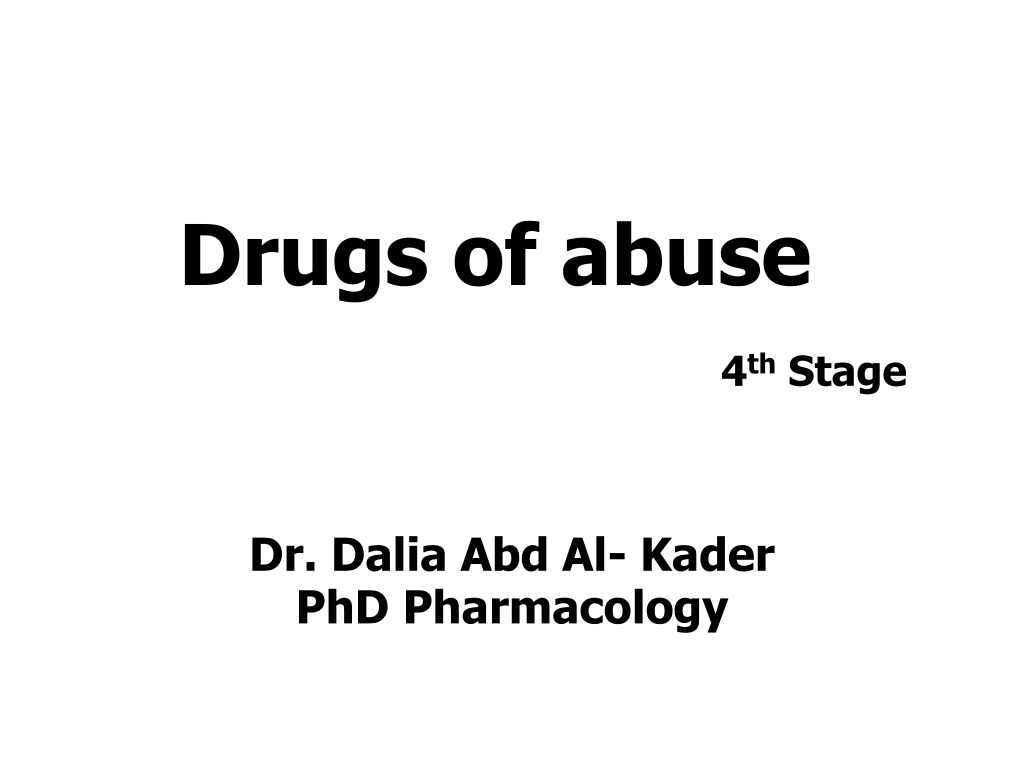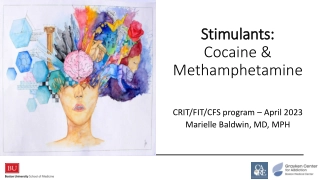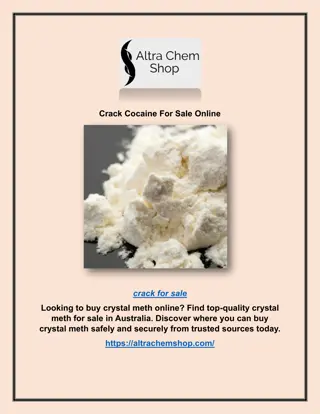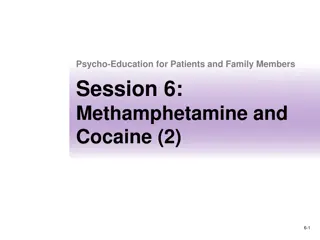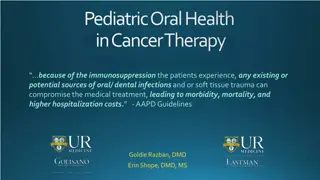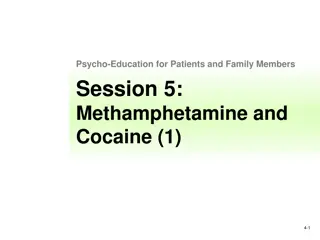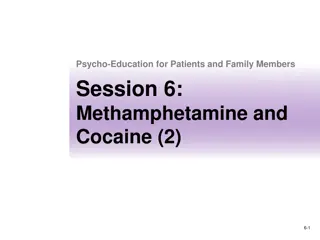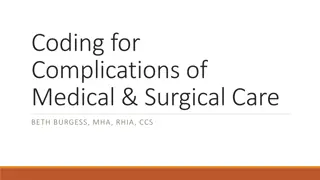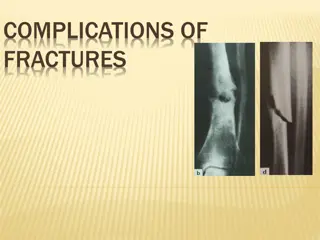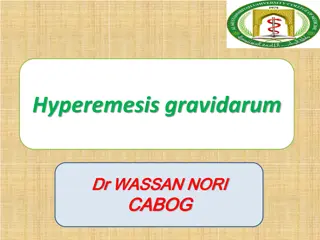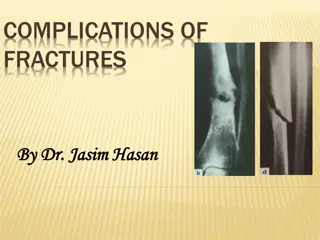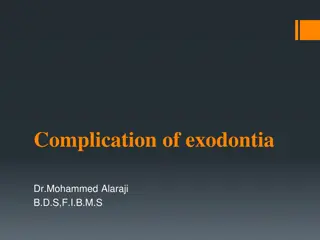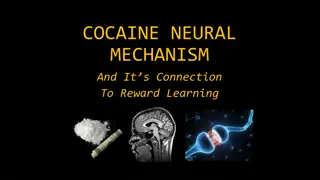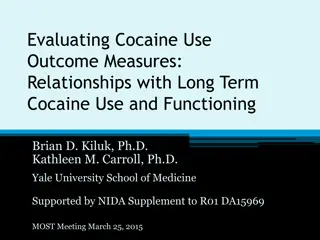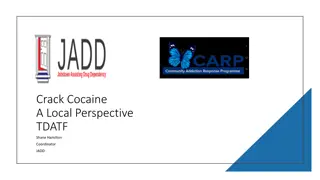Understanding Cocaine: Effects, Risks, and Complications
Cocaine is a powerful stimulant that affects the central nervous system, causing intense euphoria followed by a crash. Its effects include CNS stimulation, pleasure center activation, and potential toxicity from adulterants. Cocaine is commonly abused with alcohol, creating a cardiotoxic metabolite. Clinical manifestations of cocaine toxicity range from psychiatric complaints to chest pain and hyperthermia. Understanding the risks associated with cocaine abuse is crucial for preventing its harmful effects.
Download Presentation

Please find below an Image/Link to download the presentation.
The content on the website is provided AS IS for your information and personal use only. It may not be sold, licensed, or shared on other websites without obtaining consent from the author. Download presentation by click this link. If you encounter any issues during the download, it is possible that the publisher has removed the file from their server.
E N D
Presentation Transcript
Drugs of abuse 4thStage Dr. Dalia Abd Al- Kader PhD Pharmacology
Sympathomimetics - are stimulants that mimic the sympathetic nervous system. - produce a relative increase of adrenergic neurotransmitters at their sites of action - causing tachycardia, hypertension, hyperthermia, and tachypnea -have ability to produce pleasure
A. Cocaine - It causes CNS stimulation by inhibiting the reuptake of norepinephrine into the adrenergic neuron, thus increasing the amount of catecholamines available at the synapse. - stimulate the pleasure center of the human brain is thought to result from inhibition of reuptake of dopamine and serotonin.
- has minimal bioavailability when taken by the oral route. Instead, the cocaine hydrochloride powder is snorted, or solubilized and injected. - The cocaine powder cannot be effectively smoked, as it is destroyed upon heating. However, crack cocaine, an alkaloidal form, can be smoked, as the lungs are richly perfused with blood and carry the drug within seconds to its site of action, the brain.
- This causes an intense euphoria or rush that is followed rapidly by an intense dysphoria or crash. - so addictive. - The clinical manifestations of toxicity are not just a function of its toxicity, but also of its adulterants ( levamisole, an anthelmintic which has the ability to cause agranulocytosis (decrease in neutrophils) leaving a weakened immune system prone to opportunistic infections, which have been described among cocaine users).
- psychiatric complaints (depression precipitated by cocaine dysphoria, agitation/paranoia), convulsions, hyperthermia, and chest pain. - hyperthermia is caused by CNS stimulation that generates increased heat production, coupled with vasoconstrictive effects of cocaine. - chest pain can be chest muscle pain or cardiac in nature, as cocaine causes vasoconstriction of the coronary arteries and accelerates the atherosclerotic process.
-Commonly, cocaine is consumed with alcohol, which creates a secondary metabolite called cocaethylene. This metabolite is cardiotoxic. Cocaine chest pain can also be due to pulmonary damage caused by inhaling this hot impure substance. -Cocaine convulsions are a natural extension of the CNS stimulant effect
- Cocaine toxicity is treated by calming and cooling the patient Benzodiazepines, such as lorazepam, help to calm the agitated patient and can both treat and prevent convulsions. The calming effect helps cool the patient and manage the hyperthermia. This is an important effect, as hyperthermia is one of the major causes of cocaine fatalities. The remainder of cocaine toxicity is treated with short-acting antihypertensives, anticonvulsants, and symptomatic supportive care.
B. Amphetamines (methamphetamine) - sympathomimetic with clinical effects very similar to cocaine, last longer and be associated with more stimulation and less euphoria when compared to cocaine. - Treatment of amphetamine toxicity is similar to that of cocaine toxicity.
C. Methylenedioxymethamphetamine (MDMA), (ecstasy or Molly ) - is a hallucinogenic amphetamine with profound serotonin-releasing effects. some of the early deaths associated with MDMA toxicity involved dehydration and renal failure. MDMA can cause bruxism (teeth grinding) and trismus (jaw clenching). cause hyperthermia, altered mental status, and movement disorders known as the serotonin syndrome.
Treatment for MDMA toxicity (undertaken with the knowledge that like all street drugs, adulterants and coingestants are likely to be involved) - benzodiazepines help to calm and cool the patient. - Life-threatening hyperthermia has been treated with neuromuscular blockers and endotracheal intubation. - Cyproheptadine is a serotonin antagonist that has been used to treat serotonin syndrome.
D. Synthetic Cathinones bath salts, - not for human consumption. - Synthetic cathinones are not easily detected on urine toxicology screens. - These drugs increase the release and inhibit the reuptake of catecholamines (norepinephrine, epinephrine, and dopamine) in a manner very similar to cocaine and amphetamines. - Bath salts are generally snorted or ingested, but they may also be injected. Treatment is similar to the emergent treatment of amphetamines and cocaine.
HALLUCINOGENS A. Lysergic acid diethylamide (LSD) - -LSD : a potent partial agonist at 5-HT2A receptors. - Aside from the very colorful hallucinations, the drug is also responsible for mood alterations, sleep disturbances, and anxiety. Repeated use rapidly produces tolerance through down- regulation of the serotonin receptors LSD may cause tachycardia, increased blood pressure and body temperature, dizziness, decreased appetite, and sweating. loss of judgment , impaired reasoning and suicide.
B. Marijuana -The main psychoactive alkaloid contained in marijuana is THC. - Specific receptors in the brain, cannabinoid or CB1 receptors and found to be reactive to THC. - effects produced include physical relaxation, hyperphagia (increased appetite), increased heart rate, decreased muscle coordination, conjunctivitis, and minor pain control. - THC can produce euphoria, followed by drowsiness and relaxation.
The effects of marijuana on -aminobutyric acid (GABA) in the hippocampus diminish the capacity for short-term memory in users, and this affect seems to be more pronounced in adolescents. THC decreases muscle strength and impairs highly skilled motor activity such as that required to drive a car.
Long-term effects of use may include chronic bronchitis, chronic obstructive pulmonary disease, increased progression of HIV and breast cancer, and exacerbation of mental illness. Tolerance develops rapidly in users, and withdrawal has been observed. Marijuana may be found in the body up to 3 months after last usage in heavy chronic users. For this reason, withdrawal occurs much later in individuals who previously used marijuana heavily. Withdrawal may include depression, pain, and irritability.
THC is available as the prescription product dronabinol to treat emesis and to stimulate the appetite. C. Synthetic Cannabinoids Spice or K2. - Sympathomimetic effects may be seen in users, including tachycardia and hypertension. - the greatest danger includes extreme hallucinations.
ETHANOL - It is a major cause of fatal automobile accidents, drownings, and fatal falls and is a related factor in many hospital admissions. - Alcoholism decreases life expectancy by 10 to 15 years. - ethanol exerts its effects through enhancing the effects of the inhibitory neurotransmitter GABA, inducing the release of endogenous opioids, and altering levels of serotonin and dopamine. - Ethanol is a selective CNS depressant at low doses. At high doses, it is a general CNS depressant, which can result in coma and respiratory depression.
Ethanol is absorbed from the stomach and duodenum, and food slows and decreases absorption. Ethanol is metabolized by alcohol dehydrogenase to acetaldehyde and then by aldehyde dehydrogenase to acetate in the liver. a breath sample can be used to determine blood alcohol levels. Medical management of acute ethanol toxicity includes symptomatic supportive care and the administration of thiamine and folic acid to prevent/treat Wernicke encephalopathy and macrocytic anemia.
Chronic ethanol abuse can cause profound hepatic, cardiovascular, pulmonary, hematologic, endocrine, metabolic, and CNS damage. Sudden cessation of ethanol ingestion in a heavy drinker can precipitate withdrawal manifested by tachycardia, sweating, tremor, anxiety, agitation, hallucinations, and convulsions. Alcohol withdrawal is a life-threatening situation that should be medically managed with symptomatic/supportive care, benzodiazepines, and long-term addiction treatment.
Drugs used in the treatment of alcohol dependence: Disulfiram - blocks the oxidation of acetaldehyde to acetic acid by inhibiting aldehyde dehydrogenase. This results in the accumulation of acetaldehyde in the blood, causing flushing, tachycardia, hyperventilation, and nausea. Disulfiram has found some use in the patient seriously desiring to stop alcohol ingestion. Naltrexone is a long-acting opioid antagonist. Acamprosate
PRESCRIPTION DRUG ABUSE Some commonly abused prescription drugs include opioids, benzodiazepines, and barbiturates.
